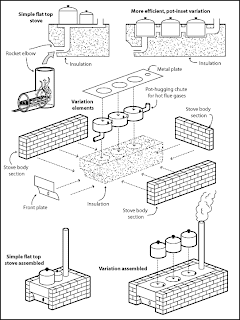The "Rocket stove principles" (see also http://en.wikipedia.org/wiki/Rocket_stove and the references at the bottom) were develop by Larry Winiarski and the good folks at Aprovecho (for example http://www.aprovecho.org/web-content/publications/pub1.htm), and they tend to be a good start for understanding how to build a stove that burns the fuel efficiently - though other design features are always being explored, and since it is just as important for cooking that we transfer the heat produced by the fire to the food, measuring the overall stove efficiency (such as using the Water Boiling Test, a calorimetry technique done by just boiling water while taking into account the estimated energy contained in the fuel) does not tell but so much about fuel burning efficiency.
tend to be a good start for understanding how to build a stove that burns the fuel efficiently - though other design features are always being explored, and since it is just as important for cooking that we transfer the heat produced by the fire to the food, measuring the overall stove efficiency (such as using the Water Boiling Test, a calorimetry technique done by just boiling water while taking into account the estimated energy contained in the fuel) does not tell but so much about fuel burning efficiency.
The principle most significant for this discussion is perhaps the mandate that we lower the effective thermal mass around the combustion chamber, so that this part heats up fast and gets as hot as possible - so that emissions (at the top of the chimney) are as low as possible. High temperatures and the right amount of air results in burning of the smoke (fire is very simplistically the oxidation of carbon, turning it into CO and CO2, and since we don't want the CO and it is a wasted energy if it escapes, then we need to burn this to make more CO2), increasing the efficiency of the stove - with all the attendant benefits that result from this.
An issue that we don't have with single pot stoves (these are used in many, many parts of the world, where people cook outside so IAP is not an issue and the single pot is exposed directly to the flames) is that plancha type stoves can be used with several cooking pots at one time so the efficiency of the stove is even harder to measure because it depends on how many pots are on the plancha and the efficiency of heat transfer may not be as good because first the plancha is heated, then the pots are heated by the  plancha. Imagine if you only have one pot on the plancha, and that it is very dented on the bottom - you are heating up the whole plancha for just this one pot (heating the room mostly - not always a bad thing) and the lumpy pot bottom will keep the food from cooking as fast. As far as I know there is no test method for determining the cooking efficiency of plancha (multi-pot) stoves so I want to try to work on this, even if just involves calorimetry using as many pots as the stove top will hold.
plancha. Imagine if you only have one pot on the plancha, and that it is very dented on the bottom - you are heating up the whole plancha for just this one pot (heating the room mostly - not always a bad thing) and the lumpy pot bottom will keep the food from cooking as fast. As far as I know there is no test method for determining the cooking efficiency of plancha (multi-pot) stoves so I want to try to work on this, even if just involves calorimetry using as many pots as the stove top will hold.
The locally built masonry stove that will often be discussed here (and many of the metal enclosed versions as well) are what I also call Justa-type stoves, after the name of one of the first stove types to use these general principles. You can Google on this name and find more resources than this page - for example here are building instructions used by the Honduran Development Association (AHDESA) in the past, who work in cooperation with Trees, Water, People.
http://www.crest.org/discussiongroups/resources/stoves/Wilmes/Buildjusta.html
and here is a 20 minute video:
video.google.com/videoplay?docid=797446823830833401
Thursday, January 17, 2008
Rocket Stove Principles
Subscribe to:
Post Comments (Atom)
No comments:
Post a Comment